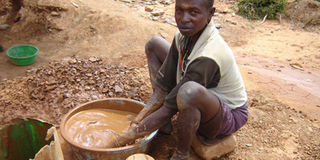Mining companies deny Karamoja land owners royalties, says report

A woman mines gold. An unfair tax system impacts low income earners more than the rich thus increasing the inequality gap. FILE PHOTO
What you need to know:
- Royalties’ revenues. Land owners are supposed to be paid 3 per cent of all royalties’ revenues.
Kampala. Land owners in Karamoja are frustrated over the failure of mining companies to pay their royalties.
According to the Mining Act, land owners are supposed to be paid 3 per cent of all royalties’ revenues. However, research conducted in April by Ecological Christian Organisation (ECO) and Uganda Consortium on Corporate Accountability (UCCA) notes otherwise.
“Royalty payments often do not reach landowners and payment problems are compounded by the complex nature of land. There is lack of clarity as to where these payments should go in those cases where mined land is communally owned,” Ms Phillo Aryatwijuka, the programme officer ECO, said.
Unknown owners
Many communities in the region, she said, were not receiving their royalties due to the communal nature of land whose rightful owners could not be verified legally. Communities in areas around Tororo Cement mining Limestone, for instance, have never received their 3 per cent in royalties.
To solve the problem, ECO and UCCA suggested that the communities organise themselves in groups to acquire communal land titles.
Other concerns raised in the study indicated that the livelihood of natives in Karamoja is being threatened as more than half the land in the region is designated for large scale mining and exploration.
Karamoja, a 27,700 square kilometre land area has more than 17,000 square kilometres licensed for mineral exploration to 51 foreign and Ugandan companies with 136 concessions exploring or actively mining.
“There is a huge quantity of land covered by exploration and mining licensees. As such, land for Artisanal and Small scale Mining (ASM) has reduced, forcing them to work within foreign concessions which are restricted grounds,” she revealed.
Artisanal and Small scale mining in Karamoja is one of the biggest economic activities in the region employing 20,000 miners with 54,000 direct and induced labourers. A total of 432,000 people in households depend on incomes from ASM.
Challenges
Challenges in the region, Ms Aryatwijuka said are worsened by lack of access to information because the communities are not aware of the concessions.
Concessionaires are also not mandated by law to reveal information of how much they mine which affects the tax revenue and royalties to be paid to the rightful land owners.
Asked if it is within the law to grant more land to miners and less for the people, lead researcher Ivan Ngobi said it depends on whether the land is owned by central government or the people where the former is permissible and the latter would be land grabbing.
On the royalties’ payment, Mr Ngobi said the companies can be held liable if they undertook a legal agreement with the land owners.
Recommendations
Sensitisation of the communities as well as strengthening already existing structures like the district mineral watch platforms to hold quarterly meetings for public to amplify their concerns.
Additionally, ECO and UCCA asked that government facilitate processes of binding Memoranda of Understanding between the mining communities and host communities to avoid exploitation.




